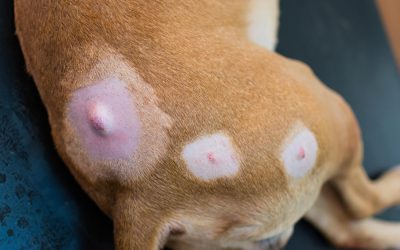Dog Tail Injuries: Causes, Types & Signs

Your dog’s tail isn’t just adorable when it wags — it’s actually a key part of how they move, balance, and communicate. Whether they’re darting around the yard, greeting you with joy, or interacting with other dogs, the tail plays a major role in their overall well-being.
What many dog owners don’t realize is that the tail is an extension of the spine. It’s made up of small vertebrae, surrounded by muscles, nerves, skin, and fur — all working together to help your dog stay steady on their feet and express how they’re feeling.
That’s why learning a little about how the tail works can go a long way. It not only helps you spot signs of injury sooner, but also reminds you just how important it is to care for this hardworking (and often overlooked) part of your furry friend.
Common Causes of Dog Tail Injuries
Tails can get hurt in many types of everyday situations — sometimes without us even realizing that something has happened.
- Accidental Bumps or Getting Caught: Tails can easily get pinched in doors or stepped on.
- “Happy Tail” Syndrome: Some dogs wag so enthusiastically that they bump into walls, furniture, or other objects, sometimes causing injury.
- Bites or Infections: Insect bites, minor scrapes, or doggie disagreements can lead to swelling, pain, or even infection.
Spotting the Signs of a Tail Injury
Your dog can’t tell you with words when their tail hurts — but they’ll show you through body language and behavior. Here are some signs to keep an eye out for:
- A Limp or Drooping Tail: A tail that suddenly droops or hangs limply may be sprained, strained, or even fractured.
- Swelling or Redness: Swelling, warmth, or redness could signal inflammation or infection.
- Changes in Behavior: Dogs may avoid playing, act more reserved, or react sensitively when their tail is touched if it’s bothering them.
Could It Be a Broken Tail? Here’s What to Look For
A broken tail can be especially painful for dogs. Keep an eye out for:
- A Visible Kink or Bend: This is often a telltale sign of a break or dislocation.
- Obvious Pain: Yelping, flinching, or avoiding touch near the tail are all signs that your dog might be in pain.
- Unusual Tail Position: If the tail is hanging abnormally or carried in an unusual manner, it may be injured.
Why Is My Dog’s Tail Down and Acting Strange?
A downward, tucked, or limp tail can sometimes mean more than just shyness or submission.
- Stress or Anxiety: Your dog might be feeling overwhelmed.
- Pain or Discomfort: Tail injuries, or even pain elsewhere in the body, can cause a droopy tail.
- Medical Conditions: Conditions like limber tail syndrome (common after swimming or overexertion) or anal gland issues might also be the cause.
Types of Dog Tail Injuries
Happy Tail
Happy tail might sound sweet, but for dogs, it can be quite painful. This happens when dogs wag their tails so enthusiastically that they repeatedly bump into walls, furniture, or other hard surfaces. Over time, these impacts can cause wounds that may be minor at first but can quickly become sore and potentially develop into chronic conditions.
Your vet may recommend:
- Gentle bandaging to protect the tail.
- An Elizabethan collar (the classic “cone”) to prevent licking or chewing.
- Pain relief or antibiotics if needed.
In some cases, if the tail doesn’t heal properly or becomes severely injured, surgery may be required to prevent ongoing discomfort. Don’t worry — dogs can still wag happily even with a shorter tail!
Limp Tail (Swimmer’s Tail or Limber Tail)
Have you ever noticed your dog’s tail suddenly hanging limp, almost as if it’s too tired to move? This is often referred to as a limp tail and is common in working or active dogs. It can be alarming, but it’s usually not a serious issue.
Possible causes include:
- Overuse of the tail from lots of wagging or swimming.
- Spending too much time in a crate with limited movement.
- Intense physical activity.
Signs you might notice:
- The tail hangs between the legs.
- Only the tip of the tail is drooping.
- Soreness or discomfort when your dog sits or wags.
Rest, love, and sometimes anti-inflammatory medication usually help your dog’s tail bounce back within days.
Why is My Dog Chewing or Biting Their Tail?
If your dog is nibbling, chewing, or even biting at their tail, they may be trying to tell you something. It could be:
- Allergies (from food, pollen, or fleas).
- Stress or anxiety.
- Itchiness due to skin conditions or nerve irritation.
- Stud Tail (an oily skin condition we’ll talk about next).
Tail chewing often leads to hair loss, irritation, or even wounds. Your vet can help identify the cause and recommend soothing treatments to bring your dog relief.
Stud Tail: More Than Just a Skin Issue
Stud tail is a skin condition that occurs when a specific gland near the base of the tail produces excessive oil. It’s most common in male dogs, especially those who haven’t been neutered, but any dog can experience it.
Signs include:
- Greasy or oily fur.
- A bad odor.
- Itchiness around the tail base.
Luckily, stud tail can usually be managed with gentle grooming, medicated shampoos, and sometimes neutering or medication, as recommended by your vet.
Hot Spots on the Tail
Hot spots are inflamed, irritated areas that can develop quickly, especially if your dog licks or scratches excessively.
Common triggers:
- Allergies
- Flea bites
- Moisture is trapped under thick fur
Hot spots can become quite uncomfortable and may even get infected. Treating them often involves:
- Gently clipping the fur around the spot.
- Cleaning with a pet-safe antiseptic.
- Using topical creams and possibly antibiotics.
- Preventing your dog from licking with an Elizabethan collar.
Your vet will guide you through keeping your dog comfortable and helping the skin heal.
Anal Gland Irritation and Parasites
As written by veterinarian Katie Grzyb, DVM in the PetMD article: ‘Anal gland issues in dogs and intestinal parasites such as tapeworms, whipworms, hookworms, and roundworms, can cause inflammation and irritation at the base of your dog’s tail or around their anus. Chewing at the base of their tail can also cause pain, infection, and hair loss.
Take your dog to the vet if you see:
- Persistent chewing at the hind end
- Scooting
- Diarrhea
- Weight loss
- Vomiting
- Live worms near the anus
Your vet will assess and possibly express your dog’s anal glands and/or they may send out a fecal sample for parasitic testing.’
Lumps, Bumps, and Swelling on the Tail
Not every lump is serious, but it’s always good to have it checked. Dogs can develop:
- Cysts — soft, fluid-filled bumps.
- Bruising — from knocking the tail during play.
- Abscesses — infected pockets of fluid.
- Tumors — which may be harmless or, in rare cases, more concerning.
Reach out to your vet if you notice:
- A lump that grows or doesn’t go away after a week.
- The lump is causing your dog discomfort.
- Bleeding, swelling, or unusual color changes.
Your vet may suggest simple monitoring or further tests to accurately diagnose the issue. While some tail fractures heal on their own, others (especially if they are near the base or involve nerves) might require surgery. Your vet will help determine the best course of action.
What to Do if Your Dog’s Tail is Bleeding
Seeing your dog’s tail bleeding can be alarming, but here’s what you can do:
- Stay Calm: Dogs pick up on your emotions, so try to stay reassuring.
- Apply Pressure: Gently press a clean cloth on the wound to help stop the bleeding.
- Clean the Area: Use a mild antiseptic to clean the wound.
- See a Vet if Needed: If bleeding is heavy or does not stop after a few minutes, it’s time to visit a vet.
Keeping a pet first-aid kit at home can make handling minor injuries much less stressful.
Is It Sprained or Broken?
It can be challenging to distinguish between a sprain and a break.
- Sprained Tails often hang limp and might seem sore, but don’t show any obvious deformity.
- Broken Tails may show a kink, bend, or even an unnatural angle.
Your vet can confirm with an exam or X-rays and advise you on the next steps to get your pup feeling better.
How Can Pet Insurance Help You if Your Dog Needs Treatment?
Pet insurance can be a valuable tool in managing the costs of treating a dog’s veterinary expenses. By having a pet insurance policy in place, you can have peace of mind knowing that you can provide medical care for your furry companion without worrying about the financial burden. Pet insurance can help cover the costs of veterinary consultations, diagnostic tests, medications, and even specialized treatments if required.
Reimbursement
This method is the most common for pet insurance companies. You pay out of pocket for the veterinarian bill, and then the insurance company reimburses you for what’s covered under the insurance plan. The steps look like this.
- You pay the vet bill after your dog’s visit.
- You fill out the pet insurance claim form.
- Submit the claim form and other required documentation to the insurer.
- After the claim is approved, you will be reimbursed for eligible expenses.
What Does Odie Pet Insurance Cover?
Pet insurance covers various veterinary expenses, providing financial protection and peace of mind for pet owners. Here are the details of the coverage options offered by Odie Pet Insurance:
Illness & Injury Plan
The Illness & Injury Plan is an all-inclusive insurance plan designed to cover a wide range of medical needs for your pet. This plan includes comprehensive coverage for various illnesses, injuries, and veterinary services. Some of the covered items include:
- Veterinary exams and consultations
- Diagnostics (e.g., X-rays, lab tests)
- Prescribed medications
- Surgeries and hospitalization
- Rehabilitation, acupuncture, or chiropractic treatments
- Medically necessary supplies
- Euthanasia and cremation
The Wellness Plan
The Wellness Plan is a monthly membership that focuses on preventive care and covers routine veterinary services.
- Provides reimbursements for routine care items such as wellness visits (exams and vaccines), testing and parasite prevention, dental cleanings and at-home dental care, vitamins, supplements, and more.
- Through Odie’s partnership with Petivity, a leader in smart pet products and proactive care, Wellness Plan members can also receive reimbursements for Petivity devices and health kits, as well as eligible Purina food and supplements.
- Total reimbursement up to $700 per year.




